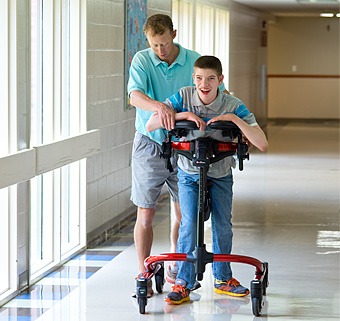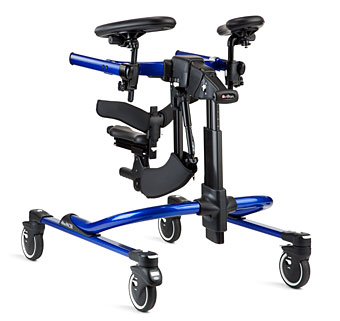
A Closer Look at Improving Mobility and Gait Patterns
Walking is a complex function and dynamic mobility features are important in gait training equipment as they assist in creating natural and more typical gait patterns. When we talk about dynamic gait training, we are appreciating the often unobserved but significant shifts of the body (as indicated by its center of gravity) particularly in the vertical and lateral directions for energy efficient and effortless walking to occur.
Vertical Displacement
In the vertical direction, the center of gravity (located in the pelvis) moves up and down following a smooth sinusoidal path with the highest point at mid-stance which adds height to help clear the contralateral swing leg as it moves through to take a step. The average vertical displacement of the center of gravity during stepping is roughly 5 cm. This up and down motion also contributes to the body’s ability to store and release energy for efficiency and highest performance levels.
Body Weight Support
Additionally, there is the concept of body-weight support (BWS) during gait. In a static system, the straps of the pelvic support are set to a fixed length. During ambulation as a patient raises and lowers their body as in stepping, the straps alternately go from slack to taut. The constancy of body-weight unloading is not guaranteed and this negatively affects gait pattern by issuing destabilizing forces to the patient.
In a dynamic system the amount of vertical unloading is kept constant while still allowing the center of gravity to move through its curve. Research shows that dynamic BWS creates more natural ground-reaction forces and gait characteristics (Frey, 2006).
Weight-Shifting
Lateral displacement of the center of gravity also follows a smooth sinusoidal curve with an average displacement of two inches. In gait this is referred to as weight-shifting. During the stance phase of gait, the center of gravity moves laterally towards the planted limb making it easier to swing the contralateral limb through to take a step.
Dynamic Gait Training Equipment 
Dynamic gait training is best achieved with a well-positioned pelvis. Efforts of the client to ambulate can then be assisted by the body-weight support of the gait trainer with its dynamic vertical and lateral movements to achieve a more normal gait pattern and easier stepping. Specialized equipment, like the Rifton Pacer, helps achieve proper pelvis position and provides the body-weight support needed for a more natural gait pattern and easier stepping.